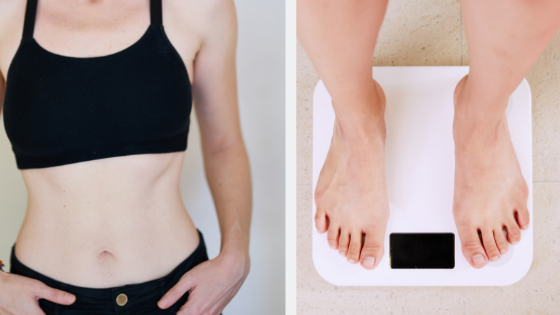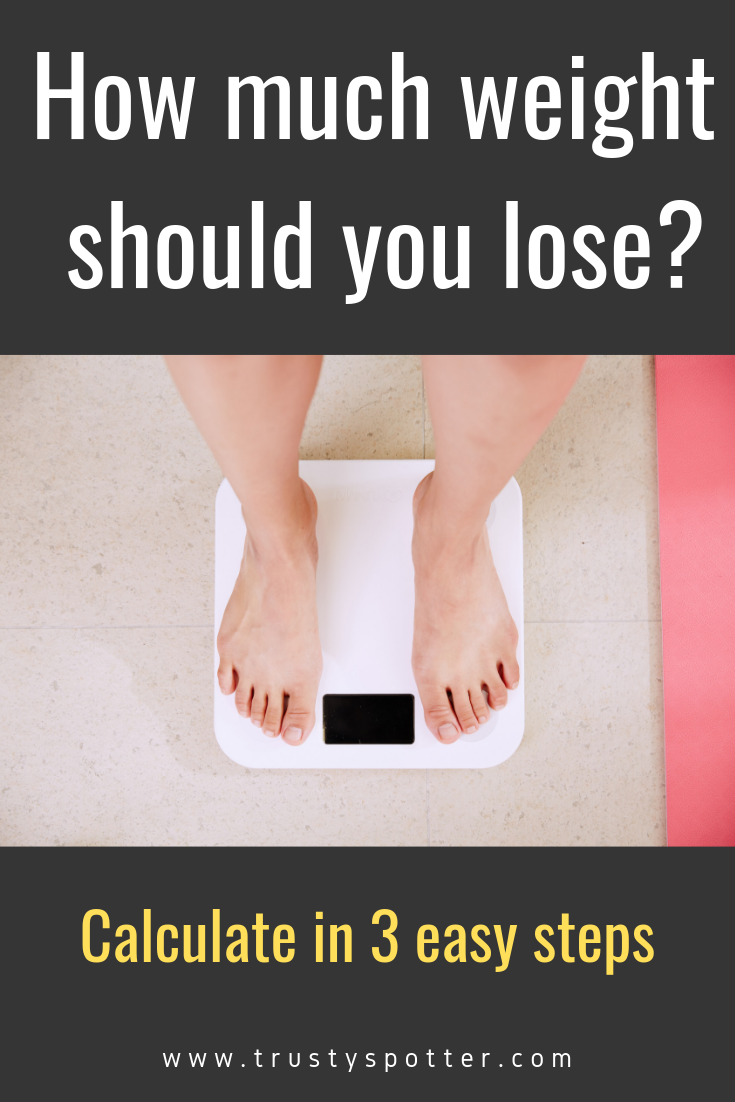Losing weight.
For many people, it’s an eternal struggle.
The process of dieting, breaking the diet, dieting some more, and doing endless cardio seems to go on forever.
One problem that holds people back is not having a clear strategy, a clear goal, and a realistic timeline of how long it will take to get there.
(Not to mention motivation to start working out in the first place.)
With that in mind, you might be wondering: How much weight should I lose?
The answer: There’s no amount you should lose. It all depends on your current weight and your goal.
To me, having a weight loss goal or body weight goal is useless. You should shoot for a bodyfat percentage goal.
Below, I’ll break down the different body fat percentage zones and roughly what each looks like. You may have to lose more or less depending on how far you want to go and where you’re starting.
In general, though, most average people (a little bit more belly fat than they’d like but not significantly overweight) will want to lose anywhere from 10-20 pounds of fat to get a more trim physique.
But it’s much, much more complicated than that. Below, I’ll walk you through everything you need to know and how to make a plan to get started!
Disclaimer: You (probably) don’t need to lose any weight
Let’s start here for just a quick moment.
You might not need to lose any weight to be healthy. There is a wide range of healthy body types, weights, and BMIs (body mass index).
Recent research puts into doubt the idea that “being fat” is inherently a health problem.
Yes, it can be correlated closely with things that ARE health problems, like:
- Cholesterol
- Diabetes
- Joint problems
- Shortness of breath
But it’s becoming more and more accepted that a few extra pounds around the middle don’t necessarily represent a big health risk if other indicators are in line.
(The exception might be if you’re classified as medically obese, which is a BMI of 30 or higher. That’s around 225 pounds for a 6 foot male. Though BMI is a notoriously horrible measure of wellness in general.)
So how much weight should you lose to be healthy? Possibly none.
And you probably shouldn’t think in those terms unless you’re obese and your doctor recommends weight loss for your health and longevity.
The most important thing to focus on is your health.
That means:
- Getting a solid balance of macro and micronutrients in your food (check out my unbiased guide to eating healthy without dieting)
- Moving your body and exercising
- Prioritizing mental health and self-image
- Watching actual health markers like blood pressure, cholesterol, and early signs of disease
Even when it comes to exercising, there are ways to improve your health that have nothing to do with your weight.
You can:
- Increase your cardio endurance – Good for your heart, lungs, and overall energy levels
- Increase your strength – Good for your muscles, bones, and longevity
All that to say, you shouldn’t feel pressured to lose weight for your health unless a doctor specifically tells you your weight is putting you at risk for health problems.
But, I totally understand that you’re probably here because you WANT to lose weight. Both for health reasons and to look and feel better.
I’ve been there myself.
So let’s talk about how to set goals for our fitness and weight loss journeys, and how to know what it’s going to take to get there.
How to figure out your end goal using body fat percentage

Most people go about weight loss all wrong because they’re too focused on a scale number.
“I want to lose 10 pounds.”
“I want to lose 50 pounds.”
When you lose weight, two things can happen:
You lose fat and muscle in roughly equal amounts: This is what happens on severely low-calorie diets, or diets with no exercise, diets with too much cardio, or diets without enough protein.
You lose mostly fat and minimal muscle, or maybe build some muscle. This is what happens when you eat a protein-rich, moderately low-calorie diet while strength training.
Most people choose door number one.
Which can be fine and very effective at slimming down! But losing fat and muscle usually just makes you look like a smaller and slightly deflated version of, well, you.
Option two has a much more dramatic impact on your appearance. It’s how you change the actual shape of your phyique and start to see muscle tone and possibly even abs.
Why? Because it alters your bodyfat percentage, or the ratio of fat to lean mass in your body.
Look, if you tell me that you’re 250 pounds, I have no freaking idea how much weight you should lose. But if you tell me what you want your physique to look like, we can figure it out.
Set a body fat percentage goal and you’ll know about how long and how intense of a diet you’ll need.
For men, here’s a quick & rough guide to body fat:
- Over 25% = Overweight
- Around 20% = Normal, a bit of fat in most key areas of the body
- 15-20% = Healthy zone, relatively trim but some belly fat
- 10-15% = Athletic, with potential for visible abs closer to 10%
- 8-10 10% = Very lean and toned, defined abs and midsection
- Under 8% = Shredded and vascular
For women, it looks a little different:
(Women naturally carry more fat in certain parts of their body)
- Over 30% = Overweight
- 30% = Curvy normal
- 25% = Slim normal
- 20-22% = Fit and athletic, some muscle tone
- 15-17% = Cut, defined abs and midsection
- 10-12% = Shredded and vascular
With that in mind, you’re ready to choose your path!
You may want to start by just trying to get to the healthy, normal, or trim zone if you’re overweight.
From there, you can set your sights on getting that lean, toned midsection and coveted abs.
(The shredded & vascular zones are mostly for stage-ready bodybuilders, certain kinds of elite athletes, and fitness professionals. It’s difficult for most people to maintain that level of leanness.)
Calculating how much weight to lose to achieve your ideal body fat
OK, time for a little math.
I promise it’ll be relatively painless. I’ll make it as easy as possible!
Here’s exactly how to calculate how much fat to lose in order to hit your physique goal.
Step one: Estimate your current bodyfat & get your current weight
You can use the rough bodyfat zones I explained above, or check out this incredibly helpful visual guide over at BuiltLean (will open in a new window so you can compare).
Just ballpark it as best you can. This won’t be an exact science anyway, you’re just trying to get an idea.
You can also weigh yourself on a bodyfat scale, though they tend to not be super accurate. A visual estimation is probably better for our purposes.
As an example, let’s say you’re a man who weighs 200 pounds and you estimate yourself to be about 20% body fat.
Step two: Calculate your lean mass
Your lean mass is sometimes referred to as muscle mass, but it actually includes things like water, bone, etc.
Basically, your lean mass is anything in your body that isn’t fat.
To figure this out is actually pretty simple
Take your estimated body fat percentage (BFP) and subtract it from 100 to get your lean mass percentage (LMP).
Then multiply your LMP x your current bodyweight to get your amount of Lean Mass in pounds
In our example, you’re a 200-pound man at 20% body fat.
That puts your lean mass at 80%. 80% of 200 (200×80/100) is 160 pounds.
Simple, right?
Step three: Determine your goal bodyweight
This is actually a super important aspect of this that a lot of people don’t think about.
Your goal should be to lose FAT, and as little muscle and lean mass as possible.
This will have the greatest impact on your appearance, body fat percentage, and overall health if you’re overweight.
(Below, I’ll dive in deeper on how to lose fat while retaining or even building some muscle, but for now let’s just assume you’ll keep 100% of your lean mass.)
The formula to find your goal bodyweight is:
Goal Body Weight = (Lean Mass (pounds) x 100) / (100 – Target Bodyfat)
Going back to our example, let’s say your goal is to get down to a healthy, fit, very achievable 15% bodyfat percentage.
Goal Body Weight = (160 pounds (lean mass) x 100) / (100-15)
Thats GBW = (160×100) / 85 = 188.23 pounds
Our goal bodyweight for a 200-pound man at 20% body fat who wants to get down to a slim, athletic 15% body is 188 pounds, which is around 12 pounds of fat loss.
If you’re head’s swimming, that’s OK. We’re done!
Just plug your own numbers and goals into the formula. Let me know in the comments if you’re getting suck.
If you just want to hear the logic and skip the numbers, basically here’s what we did:
- We took your current bodyweight and estimated body fat to find how much lean mass you have
- We know that at your goal weight, we want to keep as much of that lean mass as possible
- So we know your goal body fat percentage and your lean mass at the goal weight, so now we can work backward to find the goal weight itself
- The difference between your current weight and your goal weight is the amount of fat you’ll want to lose
Give it a try!
(Remember, this is not an exact science! For example, you probably won’t be able to retain 100% of your lean mass. And you may have under or overestimated you starting body fat percentage. But at least we have something to work from now.)
Quick guide to losing fat, NOT muscle
A big mistake a lot of people make in weight loss and dieting is completely forgetting about their muscles.
They do things like:
- Do an hour of cardio 7 days per week
- Or they don’t work out at all
- Eat extremely low calories
- Eat tons of salad, fruits, and vegetables but no protein
- And they don’t strength train!
Doing some or all of the above is a recipe for losing a lot of muscle mass.
Sure, you’ll lose fat, too. But you could get way better results if you could just convince your body to keep the muscle, lose the fat instead!
This is a pretty big topic that’s more than we can cover here, but in essence, it’s pretty simple.
Do these 3 things to keep as much muscle as possible while dieting and losing weight (you might even build some muscle):
Eat lots of protein: .8 to 1 gram per day, per pound of bodyweight, should be good. Get ready, it’s a lot more than you’re probably used to. But your body needs a lot of protein to fuel those muscles and trigger growth or retention.
Strength train: I’m a huge fan of lifting weights. You don’t need to blast your muscles every day, just hit them hard 2-3 times per week to tell your body, “Hey, I need these muscles!”
You could also do any kind of workout that provides a full body strength challenge, like yoga, BeachBody, P90X, etc.
(If you’re looking for a good program, I have a ton of suggestions depending on your gender, goal, and body type.)
Rest: Don’t kill yourself in the gym 6-7 days per week. You won’t be eating enough calories to fuel that kind of output. Workout hard 2-3 times per week and do some low key activities like walking on rest days. Your body needs to recover!
Eat enough: Yes, enough. Crash diets are a horrible idea. All you need to trigger weight loss is a small calorie deficit every day and the results will come.
Doing these 3 things will maximize your results on your diet and fitness journey.
Remember, the more lean mass you can keep (and yes, you can build muscle on a diet, especially if you’re new to training), the better you’ll look as you lose weight.
How fast can you safely lose weight? How much weight can you lose in one week?
Slow and steady wins the race.
(And keeps the weight off.)
You may have found out through the steps above that you want to lose 25, 50, or more pounds.
That probably sounds like a lot, and if you’re like me, you’re going to find it really tests your patience.
According to Mayo Clinic, losing 1 to 2 pounds per week is safe and is the usual recommendation for most people.
You may lose more a little faster if you’re obese, or you may have fast results at the very beginning of your diet as your body flushes out water.
This amounts to a deficit of 500 calories per day on average, meaning your body burns 500 calories more than you eat.
Eating somewhere around your current body weight in pounds x 12 per day is a good place to start.
(And don’t forget the protein!)
Bigger deficits than this can cause faster weight loss, but you run the risk of losing more muscle mass and burning out on the diet.
(And thus, putting the weight back on when you inevitably break and binge.)
Wrapping Up
So remember.
Don’t think so much about how much you want to weigh.
Rather, come up with a body fat percentage goal. How do you want to look? Do you want to be muscular and athletic? Do you want to be trim and lean? Do you want to be shredded?
From there, you can easily work backward to figure out how many pounds of fat you’ll need to lose to get there.
The basic plan for effective and permanent weight loss is:
- Go slow. Eat about 500 calories under maintenance (bodyweight x 12 per day) to lose 1-2 pounds per week.
- Eat enough protein. It keeps you full and triggers muscle growth or retention.
- Work your muscles. Lift. Do yoga. Do CrossFit. Do something.
- Rest. Don’t kill yourself.
- Enjoy the process. Do workouts you like. Treat yourself sometimes. Stock the house with healthy foods you enjoy. This doesn’t have to suck.
I go into a lot more detail on weight loss workouts, diets, and strategies in my article: How to finally get lean and toned.
And finally, if you want to check out the nutrition and workout plan (just 3 short workouts per week) that helped me lose over 15 pounds of fat and build some muscle, head over to my review of the Warrior Shredding Program.
Hope this has helped, everyone!

